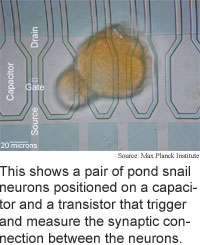
Chip controls neural connection
Researchers from the Max Planck Institute
for Biochemistry in Germany and the University of Calgary in Canada have
used a silicon chip to coax a pair of nerve cells to communicate.
The two cells communicate with each other using a chemical synapse.
When one neuron is electrically excited by a capacitor on the chip it
transmits the signal to a second cell. The activity of the second neuron
is recorded by a transistor on the chip.
In the brain, chemical synapses enable learning when connections
are strengthened by activity. The researchers were able to strengthen
the connection between the two neurons by stimulating the first neuron
with a series of pulses from a capacitor.
The researchers' device could be used to gain a better understanding
of the function of neuronal networks. If the current snail nerve cells
can be replaced with rat nerve cells, the chip could be used for pharmaceutical
screening, according to the researchers. The prototype chip is also a
step toward neurocomputers.
The method could be used for pharmaceutical screening and analysis
of neuronal networks in five years. It will take 10 to 20 years before
the method can be used to make neurocomputers in the lab. It's not possible
to tell when the method could be used to directly connect humans and electronics,
according to the researchers. The work appeared in the January 23, 2004
issue of Physical Review Letters.
Red wine mends solar cells
Search tool aids browsing
Tiny pumps drive liquid circuits
X-shape pulses hold together
Briefs:
Patterned fiber makes tiny scope
Atom spouts photons on demand
Channel shapes split microdrops
Chip controls neural connection
Atomic microscope spots viruses
Charges make micro whirlpools

Research Watch blog
View from the High Ground Q&A
How It Works
RSS Feeds:
News
Ad links:
Buy an ad link
Ad links: Clear History
Buy an ad link
|
TRN
Newswire and Headline Feeds for Web sites
|
© Copyright Technology Research News, LLC 2000-2010. All rights reserved.